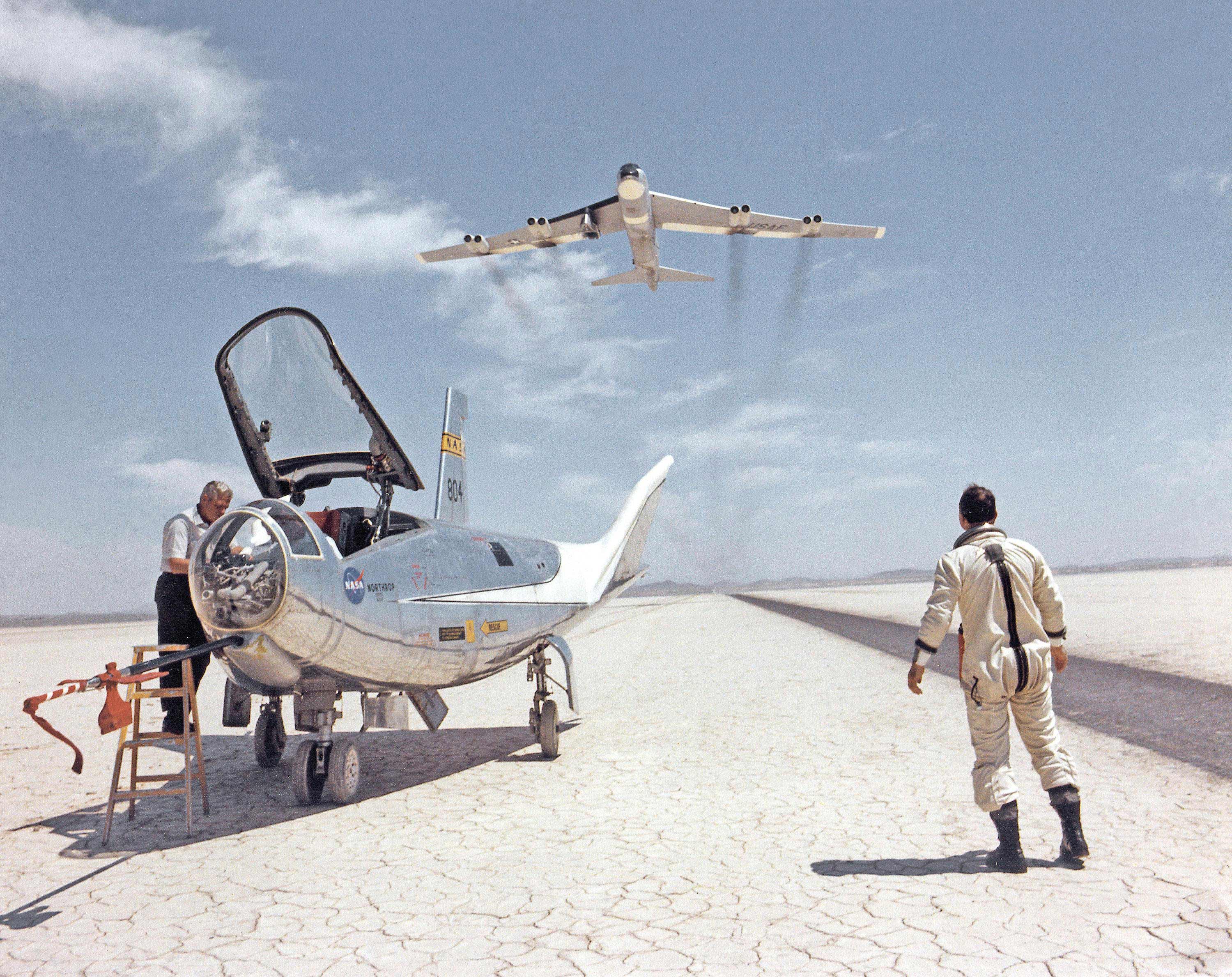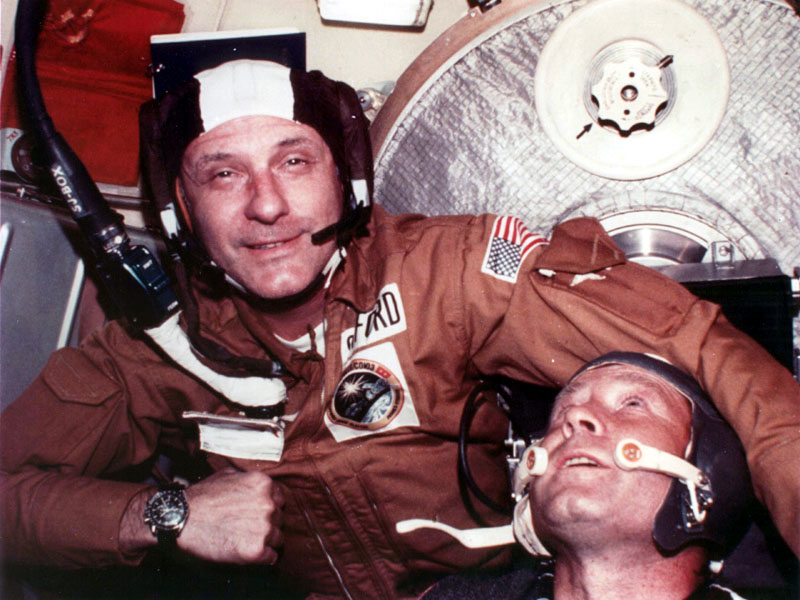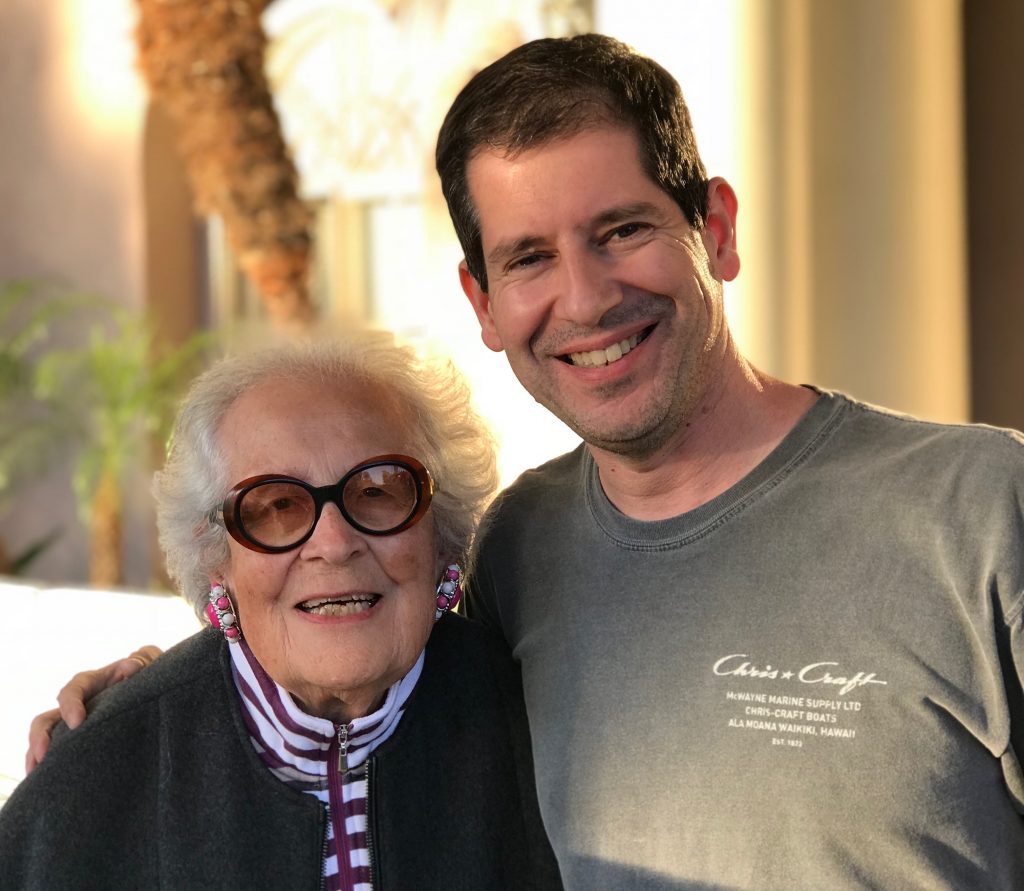
Imagine there’s no heaven
It’s easy if you try
No hell below us
Above us only sky
—“Imagine” by John Lennon
Standing at the old Rockwell International plant in Seal Beach, Jean Pinataro was anxious. It was late 1974, and Pinataro—a member of Rockwell’s design graphics group in Downey—had spent the past few months creating the official mission patch that astronauts would wear on their spacesuits during the upcoming Apollo-Soyuz mission, a historic joint U.S./Soviet Union space flight scheduled for the summer of 1975. Pinataro had already spent more than two decades working as an aviation technical artist when she got approval to join the design competition for the crew patch, but all had not gone well.
Her boss had rejected her entry and openly complained to others in the group whether it was wise to include her in the competition at all. “I came up to our room by way of the back door and was about to open it when I heard one of our designers arguing with our boss, something like, ‘You shouldn’t have included her in this competition. She is not an experienced designer,’” Pinataro wrote in a self-published, 2013 memoir. “He had to be referring to me because I was the only female artist in the group at that time.”
Pinataro felt bad, but that changed a month later when she learned that the astronauts who would be flying the mission—-Thomas Stafford, Deke Slayton and Vance Brand—had selected her design. Elated, Pinataro’s hopes were then dashed yet again when NASA officials overruled them, saying her image of the two spacecraft set against the American and Soviet flags “looked like Russia and the U.S. were dividing up the planet.” Undaunted, Pinataro took another crack at the design, this time partly basing it on a 1974 painting by Robert McCall. NASA approved the design, which was why she found herself nervously standing at the Seal Beach facility in 1974 (click here to see Pinataro’s original crew-patch design).
“Handsome Donald K. (Deke) Slayton came all the way to Downey, California, to allow me to make the changes,” Pinataro wrote. “The astronauts were rock stars to me, so I met Slayton at our Seal Beach facility with a photo of him, which he graciously signed.”

I couldn’t help but recall all this (which I knew about because Pinataro is my first cousin once removed) when I saw the trailer for the new KCET documentary series Blue Sky Metropolis, which premieres Sunday. The four-part series tells the story of how the aerospace industry helped to build California.
“Blue Sky Metropolis is a 21st-century story that looks at the past, present and future of aerospace in Southern California from multiple perspectives, including science, culture, politics, race, business, labor, environment and gender,” states KCET’s press kit on the series. “The documentary miniseries focuses on the people behind the aerospace movement and will feature many of the current major players in the aerospace industry in California, which is the hub of modern-day aerospace engineering.”
The series, which is produced in partnership with Emmy-winning filmmaker Peter Jones, is part of PBS’s “Summer of Space,” which commemorates the 50th anniversary of the first moon landing.
Though she’s not part of Blue Sky Metropolis, Pinataro’s own career in aviation illustrates just how critical aerospace was to the development of Southern California. During World War II, she went to work for Lockheed in Burbank as an aircraft assembler. “I became pretty good at working with Alclad aluminum, drilling, riveting, dimpling using a rotary saw, etc.,” she wrote in her memoir. “Women employees were required to wear hairnets so their hair would not get caught in the machinery. We also had to wear slacks. No one looked good in slacks except the actress Marlene Dietrich.”
After the war, Pinataro joined North American Aviation (which was later sold to Rockwell International). She worked first at the company’s plant near Los Angeles International Airport and later at the Rockwell Space Division in Downey. Now a technical artist, she created spacecraft renderings and illustrations of the steps for pilot ejection in the F-100D fighter manual, among other things.
“I arrived at the Downey Division [in 1967], shortly after the fire that took the lives of three astronauts in a ground test of the Apollo spacecraft,” Pinataro recalled. “I was placed in a small reports group of about 20 people. My job was to make charts, graphs and various schedules for the Apollo program.”
The Apollo spacecraft eventually landed astronauts on the moon in the late 1960s and early 1970s. Given this, it made sense that just down the hall from Pinataro’s group, the famed rocket designer Wernher von Braun—-a former Nazi who built rockets for Hitler and had helped to build the American space program after the war—maintained an office.
Orange County’s aviation legacy is no less colorful. It started in 1909, with Glenn Martin‘s 12-second flight over the Irvine Ranch–the first airplane flight in California. Three years later, he flew from Newport Beach to Catalina, an aerial feat that captured headlines around the world.
The Irvine Ranch played a huge role in the development of aviation in the county. In 1923, barnstormer Eddie Martin (no relation to Glenn) began trespassing on Irvine Ranch land near the corner of Main and Newport to give airplane rides to passengers. After cutting a lease deal with the Irvine family, Martin’s little airport ran for nearly two decades before closing in 1941 to make way for Orange County Airport (now John Wayne Airport).
Aviation expanded heavily in OC during the war, with the Marine Corps paying James Irvine $100,000 in 1942 for 4,000 acres of bean fields; the sites became the El Toro and Tustin Air Stations (the Joint Forces Training Base in Los Alamitos opened that same year as Naval Air Station Los Alamitos). The industry followed suit, with companies such as North American, Hughes Aircraft, McDonnell Douglas, Ford Aerospace and Northrop all opening plants here. The Cold War with the Soviets after World War II only led to further growth.
“In 1960, 22,000 people worked in aerospace in Orange County,” according to a June 11, 1989, Los Angeles Times story. Those who arrived in the county at that time to build helicopters, jets and rockets found wilderness-like conditions.
“There was a shepherd herding his flock,” Stan Cutter, who joined Hughes in 1960, said in the 1989 Times story. “Every now and then, a wild pheasant would cross the road, and I thought, ‘Gee, what a great place to work. It’s like being in the country.’ Then one day [several years later], you saw the bulldozers and earth-movers coming, and you knew that was the end of the sheepherder.”
By 1989, when the Times published its retrospective, 96,000 people worked in aerospace in Orange County. It was the high point for the industry not only here, but also throughout California. The fall of the Berlin Wall that year led to the collapse of the Soviet Union and the end of the Cold War, which in turn spurred massive corporate consolidation and cutbacks. From 1990 to 2010, aerospace-industry employment in Orange County dropped an astonishing 63 percent, according to a 2012 study by the Los Angeles County Economic Development Corporation.

The Seal Beach plant where Pinataro asked Slayton for his autograph is still there, though it’s now owned by Boeing. The El Toro and Tustin Marine bases closed in 1999 and are slowly being redeveloped into commercial and residential properties. Martin Aviation, the aircraft-maintenance company started by Eddie Martin and his brothers so many decades ago, remains at John Wayne Airport, though developer William Lyon bought it in 1990. Today, Lyon also keeps a pretty sweet museum there, loaded with air-worthy World War II-vintage bombers and other aircraft.
Pinataro is still around, too, though at 95, she doesn’t really give interviews anymore. “At some point, I told my nephew that I did not want a church service when I go out,” she wrote near the end of her memoir. “I just want you to sing and play John Lennon’s ‘Imagine’ at my graveside.”
Blue Sky Metropolis airs on KCET. The first episode is Sun., 8 p.m. Click here for more information.
Anthony Pignataro has been a journalist since 1996. He spent a dozen years as Editor of MauiTime, the last alt weekly in Hawaii. He also wrote three trashy novels about Maui, which were published by Event Horizon Press. But he got his start at OC Weekly, and returned to the paper in 2019 as a Staff Writer.


Restrictive Covenants were struck down in 1948, Lakewood CA had many Jewish families, and a Synagogue began it’s formal establishment in 1952. http://www.csclakewood.org/about/history/
My Jewish family was one of the “Developers” of post-WW!! California. We could live anywhere we wanted. With the advent of HUD money in the post war years, we developed many tracts, residential buildings, and malls, Newbury Park is especially relevant, since all the street names are family names, including Wendy Drive, which is my cousin, it’s an on/of framp off to the Ventura Freeway in Thousand Oaks. (Louis Lesser Enterprises)
Blue Sky Metropolis is bogus, and does not reflect my experience as a baby boomer growing up in SoCal, or my friends whose parents worked in the aerospace industry. This is how the past is distorted by time, prejudice, and bigotry, and illustrates the hypocrisy of selective “deconstructive” thought dividing us all.